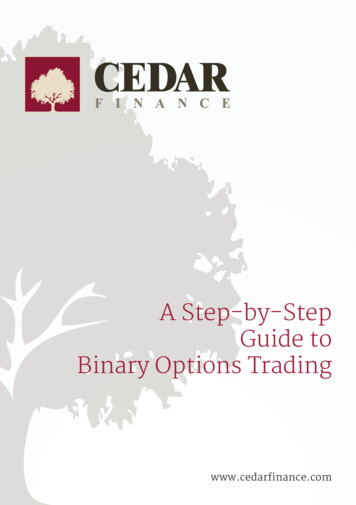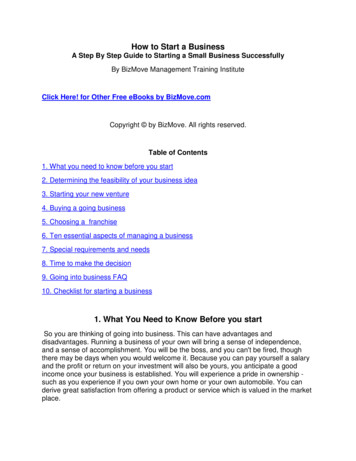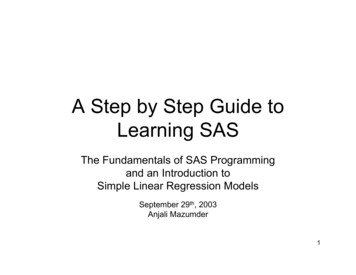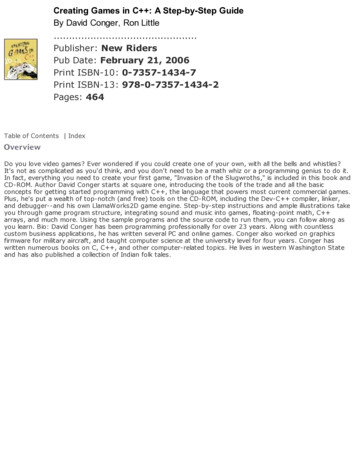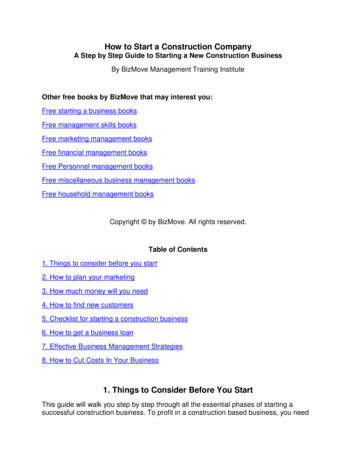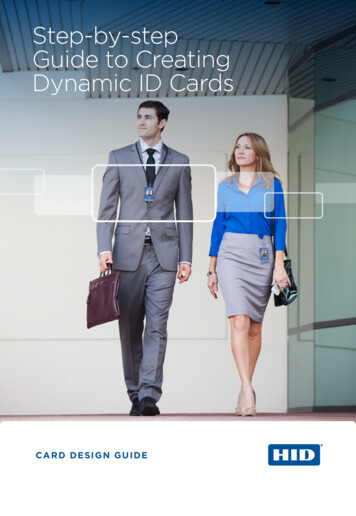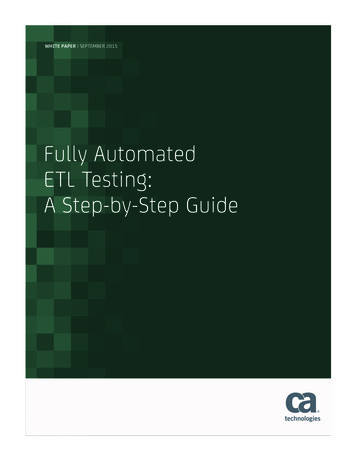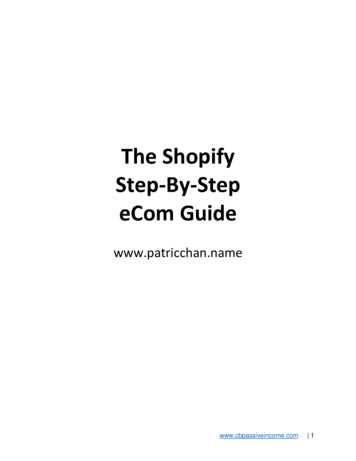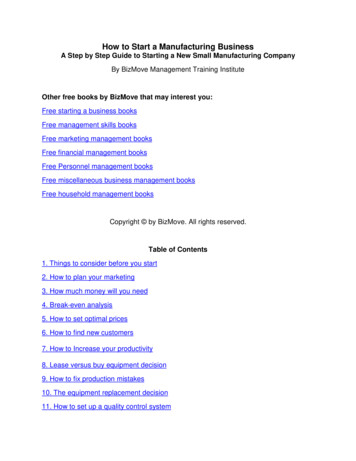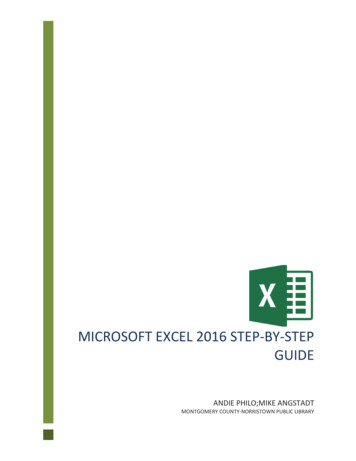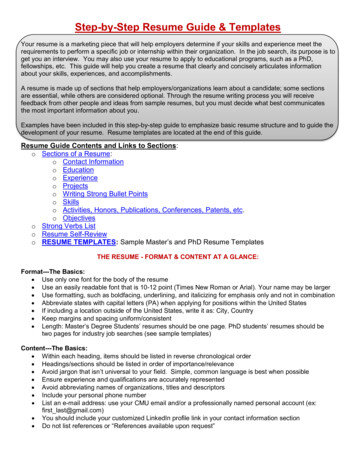
Transcription
Step-by-Step Resume Guide & TemplatesYour resume is a marketing piece that will help employers determine if your skills and experience meet therequirements to perform a specific job or internship within their organization. In the job search, its purpose is toget you an interview. You may also use your resume to apply to educational programs, such as a PhD,fellowships, etc. This guide will help you create a resume that clearly and concisely articulates informationabout your skills, experiences, and accomplishments.A resume is made up of sections that help employers/organizations learn about a candidate; some sectionsare essential, while others are considered optional. Through the resume writing process you will receivefeedback from other people and ideas from sample resumes, but you must decide what best communicatesthe most important information about you.Examples have been included in this step-by-step guide to emphasize basic resume structure and to guide thedevelopment of your resume. Resume templates are located at the end of this guide.Resume Guide Contents and Links to Sections:o Sections of a Resume:o Contact Informationo Educationo Experienceo Projectso Writing Strong Bullet Pointso Skillso Activities, Honors, Publications, Conferences, Patents, etc.o Objectiveso Strong Verbs Listo Resume Self-Reviewo RESUME TEMPLATES: Sample Master’s and PhD Resume TemplatesTHE RESUME - FORMAT & CONTENT AT A GLANCE:Format---The Basics: Use only one font for the body of the resume Use an easily readable font that is 10-12 point (Times New Roman or Arial). Your name may be larger Use formatting, such as boldfacing, underlining, and italicizing for emphasis only and not in combination Abbreviate states with capital letters (PA) when applying for positions within the United States If including a location outside of the United States, write it as: City, Country Keep margins and spacing uniform/consistent Length: Master’s Degree Students’ resumes should be one page. PhD students’ resumes should betwo pages for industry job searches (see sample templates)Content---The Basics: Within each heading, items should be listed in reverse chronological order Headings/sections should be listed in order of importance/relevance Avoid jargon that isn’t universal to your field. Simple, common language is best when possible Ensure experience and qualifications are accurately represented Avoid abbreviating names of organizations, titles and descriptors Include your personal phone number List an e-mail address: use your CMU email and/or a professionally named personal account (ex:first last@gmail.com) You should include your customized LinkedIn profile link in your contact information section Do not list references or “References available upon request”
THE SECTIONS OF A RESUMERESUME HEADINGSThe top of your resume should highlight your name, email and phone number. Unlike the remainder of yourresume, no heading is required for your contact information. All sections that follow should have headings thataccurately describe their content. This guide will review the basic headings that you may include in your initialresume. You must evaluate the most important items from your background and determine the mostappropriate order for the sections of your resume. Your career consultant can assist you in this process.CONTACT INFORMATIONYou should begin your resume with this information at the top. Be sure that the phone number you list will beanswered by YOU and has a professional outgoing voicemail message. You SHOULD also list your emailaddress (same rule applies, use one that you check often) and your customized LinkedIn URL in this section. Itis optional to include a personal website or online portfolio.For example:Firstname M. Lastnamexxx1234@andrew.cmu.edu (412) 555-5555 www.linkedin.com/firstlastYou SHOULD NOT include: Personal information: birth date, marital status, height, weight, personal identity information (socialsecurity number, passport info), etc. Any pictures. References: It is not necessary to indicate references are available upon request. You should havecontact information for your references, on a separate document, as some companies may requirethem. You should request permission from references (to serve as a reference) prior to sharing theirinformation.EDUCATIONEducation should appear as the first section of a graduate resume. Start with your most recent educationalexperience: Carnegie Mellon University. Bold university names and spell them out completely. List yourDegree (Complete and Proper Degree Name as it appears on your records) and Graduation Date.Must include:Name of Institution and locationMajor and Minors/Field of studyMonth & Year of graduation OR anticipated graduation dateDegree awarded or to be awardedOptional to Include:GPASelected CourseworkForeign Study and Exchange ProgramsName and brief descricption of thesis topic (if applicable)Below is an example of the education section:EDUCAT IONCarnegie Mellon UniversityMaster of Science in Electrical and Computer EngineeringGPA: 3.71/4.00Indian Institute of TechnologyBachelor of Science in Electrical and Computer EngineeringGPA: 9.0/10.0 Pittsburgh, PAMay 2021Mumbai, IndiaJune 2019GPA: If you include your GPA, make sure you include the scale (ex. 3.3/4.0 or 8.7/10.0). See yourCareer Consultant to discuss if you have questions.
COURSEWORKAny relevant coursework that you include is recommended to be listed under a separate heading orsubheading (within Education), as “Relevant Coursework” or “Selected Coursework.” Do NOT simply list everycourse you've taken. Only highlight those courses that are most relevant to the positions/field that you plan topursue. If listing both undergraduate and graudate courses, labels should be included.For Example:GRADUATE COURSEWORKEnergy (Conversion and Utilization)Combustion and Air PollutionAdvanced ThermodynamicsEnergy (Policy and Economics)Energy System ModelingIndustrial EcologyIt is sometimes of greater value to instead include the skills you learned in the courses in a morerobust “Skills” section and/or projects from the courses in your “Academic Projects” section.The location of the “coursework” section varies depending upon the contents of your other sections. Contactyour career consultant for advice on the order of your resume content.EXPERIENCEWe advise you to have your resume reviewed by your Career Consultant as your consultant may providefeedback regarding the customization of your resume section(s) and what content to include. As you gainexperience you may have more narrowly focused sections such as “Academic Research Experience,”“Professional Experience,” etc. “Experience” as a standalone title implies employment. If the information youhave included in an “Experience” section is not in fact employment, then you should rename that section tomore accurately reflect the nature of the entry and/or move the entry to a more appropriately titled section.A header for each employment experience entry should include:Job/Position TitleOrganization nameLocation (city and state or equivalent)Dates (month and year format or term and year for academic year related experiences)Bold the most important piece of information which is typically your job title or the company.For Example:EX P ER I EN C EBest Engineering CompanyPalo Alto, CAHardware Engineering InternJune-August 2019 Led a four-week project evaluating the design of a product in development identifying a cost reduction of 10% Developed factory test requirements and participated in factory site visits to oversee successful testing Presented project proposal and findings to senior leadership, resulting in favorable feedback andrecommendation for inclusion in the new product’s designAfter the header, describe your experience and results using action-oriented statements. Start each statementwith an action verb. You should use consistent punctuation for your bullets (remember, these bullet points donot require periods, semi-colons, etc.).Try to write one phrase per line when possible, but no more than two lines per bullet point. Use bullets toindicate new lines. Review the Action Verbs List (enclosed) for assistance in selecting a variety of strong verbsfor your resume.
PROJECTSWe also suggest that you select a number of academic and/or research projects to highlight on your resume.This serves to further provide examples of your experience and to illustrate practical applications of yourskillset.For Example:ACADEMIC PROJECTSRobot Design and BuildSpring 2019Carnegie Mellon UniversityPittsburgh, PA Designed and constructed circuits using a protoboard to power a beeper, LED, clock, memory chip, and twomotors Combined circuits to create a mini programmable robot and successfully programmed the robot to complete atest course with zero failures or errorsFOCUS ON RESULTS- Experience & ProjectsResumes are assessed to determine if candidates have the appropriate proven results and experience for thegiven organization/position. List your key achievements and add details which show your demonstratedresults.Begin sentences with action verbs (past tense unless it’s a current activity/project) and be specific whendetailing your results and the value you added to each experience.Use this formula to get started:Action Verb Context (tell the what and the how) Result (Metrics, Outcome, and/or Impact)Review the following samples: Developed UI feature enhancements with C to extract user inputs, transfer data to simulation engine,and visualize results in 2D and 3D plots Created MEP 3D model using Revit and collaborated with cross-functional team to integrate models inSolibri; performed clash detection to overcome discrepancies in design and model Formulated traditional machine learning and neural network models using pytorch library to predictmulti-pedestrian behavior and evaluate AV-pedestrian interaction scenarios Developed a proprietary algorithm that automated the post-operation assessment of drilling data andidentified costs of 100,000 per well pad were mitigatable through identified best practices Researched and analyzed the data of various fuel cells to determine the optimal experimentalparameters and to understand the diameter-dependent lithium storage performance Led agile sprints, feature prioritization, and roadmap development to ensure timely delivery of newfintech software productWhen constructing the detail of this section, as a graduate student, your resume should encompass the mostrelevant experience from your undergraduate work to present day. The more current/recent and relevant (toyour job/internship search) an experience is, the more detail you should provide.SKILLSList any relevant skills specific to your field including technical, lab, and knowledge-based skills you can applyto your field. Sub-categorize your skills whenever possible. List/label skills and foreign language proficiencies(if your proficiency levels vary). Do not include soft skills such as “teamwork” or “leadership” in this section.For example:S KI L L SApplication Software: MATLAB, SolidWorksProgramming Languages: C/C , Java, PythonLanguages: English (Fluent), French (Conversational), Hindi (Native Speaker)
ACTIVITIES, HONORS, PUBLICATIONS, CONFERENCES & PATENTSActivitiesList memberships in campus and professional organizations or other activities that show involvement in youracademic community or profession. Especially include those in which you had a leadership position.HonorsHonors, Scholarships, Fellowships, and Awards should be listed, if received. Depending on the type of honor,these honors may be embedded within other sections or experiences OR if robust/varied enough, included asa standalone section. Select only those awards or honors that represent your strengths and are timely (i.e. youwill not include high school honors).PublicationsPublications can be listed in a separate section if numerous, or under the relevant research/work experience.Conference PresentationsConference presentations can be listed in a separate section if numerous, or under the relevant research/workexperience section to which they apply.For example:HO NO R S & L E A D ER S HI PDean’s Award, College of Engineering – Best Academic PerformanceChapter President, Society of Women EngineersSpring 2019Fall 2018- Spring 2019OBJECTIVE/SUMMARYThe use of an objective/summary is optional.If you decide to include an objective or summary, describe the career path that you are pursuing, and yourskills/experiences that will enable you to add value to an organization. If your objective/summary isn’t addingclarity and advancing your purpose and resume, remove it.WHY INCLUDE A CAREER OBJECTIVE OR SUMMARY ON YOUR RESUME? If you have a diverse orvaried background, it may help to focus your resume and provide clarity to an employer on your career goals,your related skills and the value you can add to the prospective organization.Consider the following when writing an objective/summary: Focus on what skills, experiences and abilities that you possess that would bring value to theemployer and position to which you intend to apply. Avoid broad/generalized statements such as, “To pursue the computer engineering field.” Avoid listing several fields or positions. It is acceptable to have two resumes with two different objectives or summaries and to tailorresumes to different job searches.
Strong Verbs edconfrontedestablishedi
Step-by-Step Resume Guide & Templates . Your resume is a marketing piece that will help employers determine if your skills and experience meet the requirements to perform a specific job or internship within their organization. In the job search, its purpose is to get you an interview. You may also use your resume to apply to educational programs, such as a PhD, fellowships, etc. This guide .

